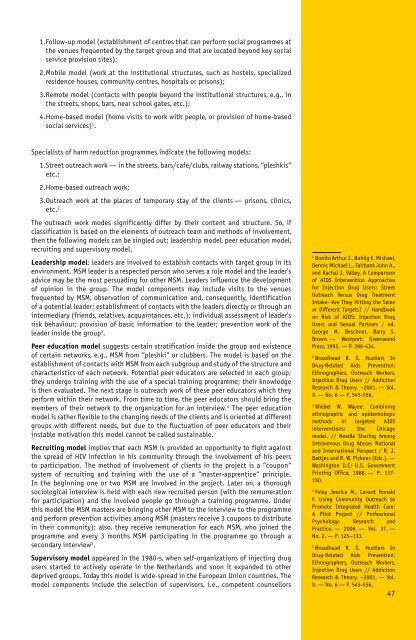Social Work with People Practicing Same-Sex ... - ILGA Europe
Social Work with People Practicing Same-Sex ... - ILGA Europe
Social Work with People Practicing Same-Sex ... - ILGA Europe
Create successful ePaper yourself
Turn your PDF publications into a flip-book with our unique Google optimized e-Paper software.
1. Follow-up model (establishment of centres that can perform social programmes at<br />
the venues frequented by the target group and that are located beyond key social<br />
service provision sites);<br />
2. Mobile model (work at the institutional structures, such as hostels, specialized<br />
residence houses, community centres, hospitals or prisons);<br />
3. Remote model (contacts <strong>with</strong> people beyond the institutional structures, e.g., in<br />
the streets, shops, bars, near school gates, etc.);<br />
4. Home-based model (home visits to work <strong>with</strong> people, or provision of home-based<br />
social services) 1 .<br />
Specialists of harm reduction programmes indicate the following models:<br />
1. Street outreach work — in the streets, bars/cafe/clubs, railway stations, “pleshkis“<br />
etc.;<br />
2. Home-based outreach work;<br />
3. Outreach work at the places of temporary stay of the clients — prisons, clinics,<br />
etc. 2<br />
The outreach work modes significantly differ by their content and structure. So, if<br />
classification is based on the elements of outreach team and methods of involvement,<br />
then the following models can be singled out: leadership model, peer education model,<br />
recruiting and supervisory model.<br />
Leadership model: leaders are involved to establish contacts <strong>with</strong> target group in its<br />
environment. MSM leader is a respected person who serves a role model and the leader's<br />
advice may be the most persuading for other MSM. Leaders influence the development<br />
of opinion in the group. The model components may include visits to the venues<br />
frequented by MSM, observation of communication and, consequently, identification<br />
of a potential leader; establishment of contacts <strong>with</strong> the leaders directly or through an<br />
intermediary (friends, relatives, acquaintances, etc.); individual assessment of leader's<br />
risk behaviour; provision of basic information to the leader; prevention work of the<br />
leader inside the group 3 .<br />
Peer education model suggests certain stratification inside the group and existence<br />
of certain networks, e.g., MSM from “pleshki“ or clubbers. The model is based on the<br />
establishment of contacts <strong>with</strong> MSM from each subgroup and study of the structure and<br />
characteristics of each network. Potential peer educators are selected in each group;<br />
they undergo training <strong>with</strong> the use of a special training programme; their knowledge<br />
is then evaluated. The next stage is outreach work of these peer educators which they<br />
perform <strong>with</strong>in their network. From time to time, the peer educators should bring the<br />
members of their network to the organization for an interview. 4 The peer education<br />
model is rather flexible to the changing needs of the clients and is oriented at different<br />
groups <strong>with</strong> different needs, but due to the fluctuation of peer educators and their<br />
instable motivation this model cannot be called sustainable.<br />
Recruiting model implies that each MSM is provided an opportunity to fight against<br />
the spread of HIV infection in his community through the involvement of his peers<br />
to participation. The method of involvement of clients in the project is a “coupon“<br />
system of recruiting and training <strong>with</strong> the use of a “master-apprentice“ principle.<br />
In the beginning one or two MSM are involved in the project. Later on, a thorough<br />
sociological interview is held <strong>with</strong> each new recruited person (<strong>with</strong> the remuneration<br />
for participation) and the involved people go through a training programme. Under<br />
this model the MSM masters are bringing other MSM to the interview to the programme<br />
and perform prevention activities among MSM (masters receive 3 coupons to distribute<br />
in their community); also, they receive remuneration for each MSM, who joined the<br />
programme and every 3 months MSM participating in the programme go through a<br />
secondary interview 5 .<br />
Supervisory model appeared in the 1980-s, when self-organizations of injecting drug<br />
users started to actively operate in the Netherlands and soon it expanded to other<br />
deprived groups. Today this model is wide-spread in the <strong>Europe</strong>an Union countries. The<br />
model components include the selection of supervisors, i.e., competent counsellors<br />
1 Bonito Arthur J., Bohlig E. Michael,<br />
Dennis Michael L., Fairbank John A.,<br />
and Rachal J. Valley. A Comparison<br />
of AIDS Intervention Approaches<br />
for Injection Drug Users: Street<br />
Outreach Versus Drug Treatment<br />
Intake--Are They Hitting the <strong>Same</strong><br />
or Different Targets? // Handbook<br />
on Risk of AIDS: Injection Drug<br />
Users and <strong>Sex</strong>ual Partners / ed.<br />
George M. Beschner, Barry S.<br />
Brown. — Westport: Greenwood<br />
Press, 1993. — P. 396-434.<br />
2 Broadhead R. S. Hustlers In<br />
Drug-Related Aids Prevention:<br />
Ethnographers, Outreach <strong>Work</strong>ers,<br />
Injection Drug Users // Addiction<br />
Research & Theory. –2001. — Vol.<br />
9. — No. 6 — P. 545-556.<br />
3 Wiebel W. Wayne. Combining<br />
ethnographic and epidemiologic<br />
methods in targeted AIDS<br />
interventions: the Chicago<br />
model. // Needle Sharing Among<br />
Intravenous Drug Abuse: National<br />
and International Perspect / R. J.<br />
Battjes and R. W. Pickens (Eds.). —<br />
Washington D.C: U.S. Govemment<br />
Printing Office, 1988. — P. 137-<br />
150.<br />
4 Foley Jessica M., Levant Ronald<br />
F. Using Community Outreach to<br />
Promote Integrated Health Care:<br />
A Pilot Project // Professional<br />
Psychology: Research and<br />
Practice. — 2006. — Vol. 37. —<br />
No. 2. — Р. 125–131.<br />
5 Broadhead R. S. Hustlers In<br />
Drug-Related Aids Prevention:<br />
Ethnographers, Outreach <strong>Work</strong>ers,<br />
Injection Drug Users // Addiction<br />
Research & Theory. –2001. — Vol.<br />
9. — No. 6 — P. 545-556.<br />
47


